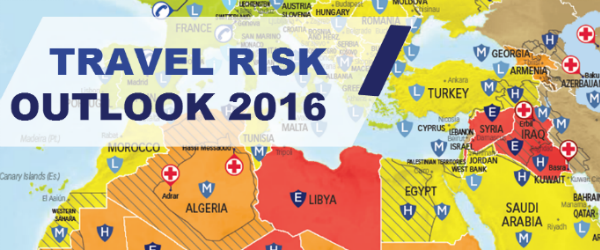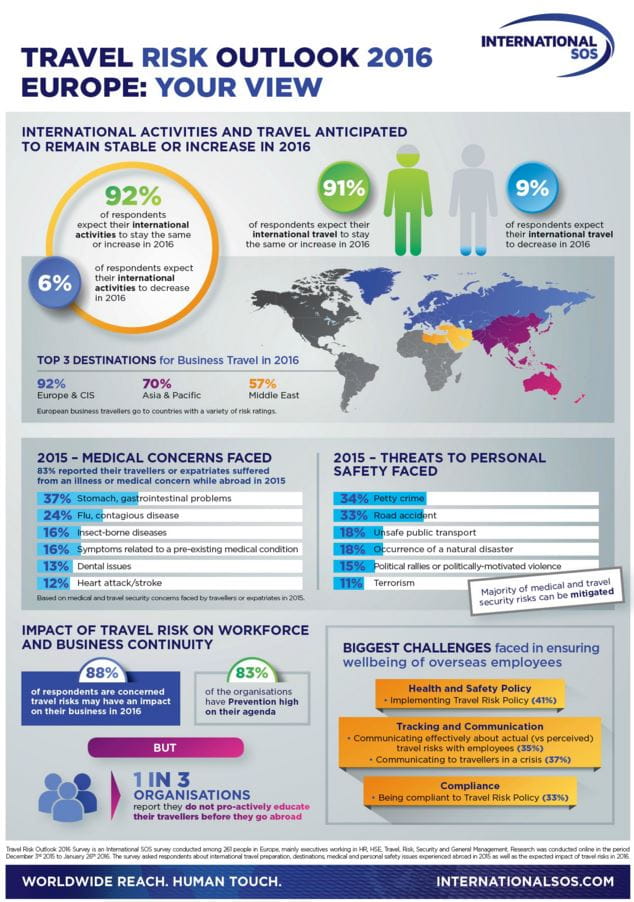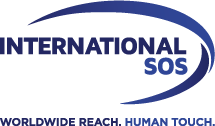European Travel Risk Outlook
Paris
European Organisations are Concerned about Travel Risks Impacting their Business
Nearly one in three trips abroad are to countries with higher risk than the traveller’s home country1

- 88% of organisations are concerned about travel risks affecting their business in 2016.
- 83% reported their travellers or expatriates suffered from an illness or medical concern while abroad.
- Petty crime and road accidents most common threat to personal safety while travelling abroad.
- One third of organisations do not pro-actively educate their people before they travel abroad.2
International SOS, the world’s leading medical and travel security services company, conducted a Travel Risk Outlook 2016 survey2 among European organisations from December 3rd 2015 till January 26th 2016.
Business travel is expected to continue or grow, with 91% of the survey respondents indicating international travel within their organisation is likely to remain at the same level or to increase in 2016. Asia and the Pacific were selected as the most likely travel destinations outside of Europe, followed by the Middle East.
Medical concerns faced by travellers are largely preventable
While 83% or respondents reported their travellers or expatriates suffered from an illness or medical concern while abroad in 2015, many of the illnesses reported could be preventable.
Stomach and gastrointestinal problems (37%), flu and contagious diseases (24%), and insect-borne diseases (16%) such as malaria were some of the most common illnesses or medical concerns reported by European organisations in 2015.
Dr Lars Petersen, Regional Medical Director at International SOS, Benelux & Scandinavia:
“These issues are to a large extent preventable. Most of the health risks travellers face can be mitigated by systematic and comprehensive planning. Access to quality health information, advice on vaccinations and prophylaxis, good internal communication, and a solid preventive health check programme are all best practices for organisations with global travellers.”
Terrorism threat is in travellers’ mind
Eleven per cent of travellers experienced terrorism as a threat to their personal safety while travelling abroad in 2015.
Tim Willis Regional Security Director of Northern Europe at International SOS and Control Risks, commented on the results:
“This percentage is relatively high. However, as a threat it is far less common than the top three safety and security risks travellers cited of concern in 2015, which were petty crime (34%), road accidents (33%) and unsafe public transport (18%). Therefore, our advice to organisations is to ensure their assessments of risks are based on reality and not perception.”
Travel risk mitigation is key
A key outcome of the survey was that 88% of respondents are concerned travel risks may have an impact on their business in 2016. Whilst many risks may be mitigated, one in three organisations reported they do not pro-actively educate their travellers before they go abroad.
In order to help organisations better understand the risks in the markets where they operate and travel, International SOS and Control Risks recently launched Travel Risk Map 20163 which displays each country’s medical risk rating and travel security risk rating. The map can aid organisations and staff in their travel risk mitigation efforts.
Tim Willis concluded:
“The reality is there are risks everywhere in the world. Understanding what those risks are, and then taking appropriate precautions such as assessing exposure to risks, monitoring events in the region, and providing pre-travel training* is the best way to support your staff, enable business growth and deliver on duty of care.
Moreover, having a holistic Travel Risk Management process rather than basing your preparedness on piecemeal risks in individual countries is critical for any type of organisation.”
About International SOS and Control Risks
Our alliance brings together two of the world’s leading medical and security specialists, International SOS and Control Risks. Our combined resources and expertise are well placed to meet the customers’ growing need for integrated travel security risk services. Our solutions ensure that mobile employees are safe and productive and help employers with their duty of care obligations. 50 dedicated experts, located across the globe with access to over 200 dedicated travel security experts through 26 regional Assistance Centres and a partner network of over 700 accredited providers, produce global travel security information and analysis 24/7. We also provide travel security training, preventative travel assessment, support with the development of travel security risk policies, evacuation plans and the latest technology to enable clients to track and communicate with their mobile employees.
Notes to Editors
*About International SOS Training Services
International SOS has launched a new Training Hub, a brand new way for business travellers and expatriates to experience Medical and Travel Security Training Services. It includes a range of training programmes that cover personal security tips, real scenarios, decision-making skills and destination-specific awareness.
1. International SOS TravelTracker data. International flights completed by 5,364,980 travellers between 1 October 2014 – 30 September 2015.
2. Travel Risk Outlook 2016 Survey is an International SOS survey conducted among 261 people in Europe, mainly executives working in HR, HSE, Travel, Risk, Security and General Management. Research was conducted online in the period December 3rd 2015 to January 26th 2016. The survey asked respondents about international travel preparation, destinations, medical and personal safety issues experienced abroad in 2015 as well as the expected impact of travel risks in 2016.
3. Travel Risk Map 2016. International SOS and Control Risks, December 2015. Learn more about Travel Risk Map 2016 and view the map online at www.internationalsos.com/travelriskmap. An interactive digital version is also available.









